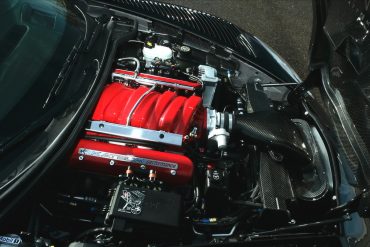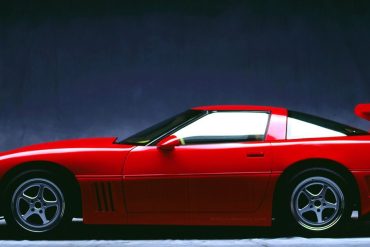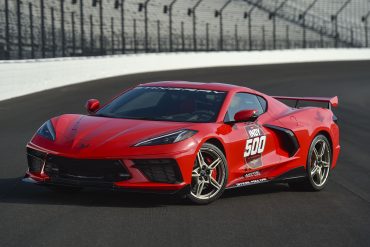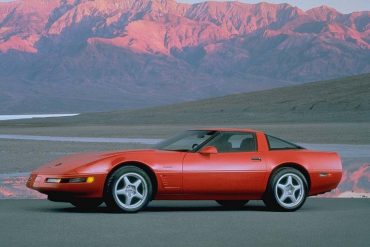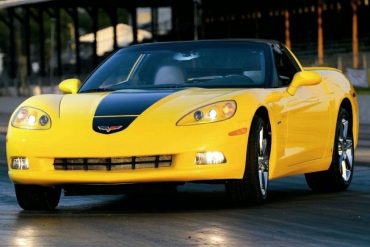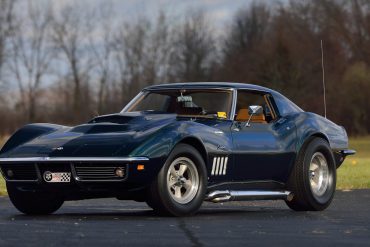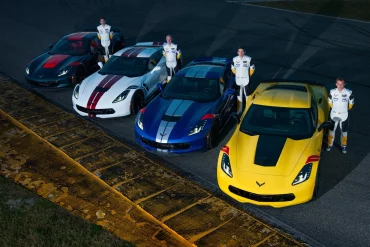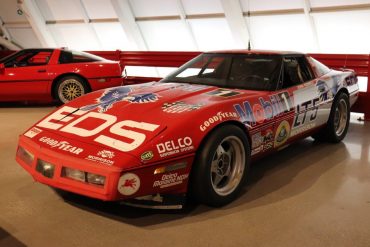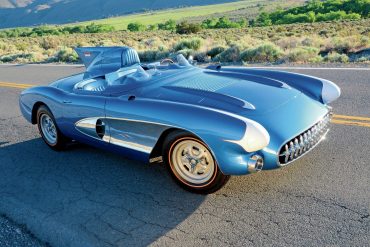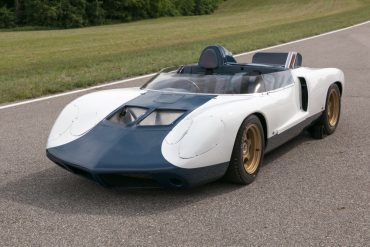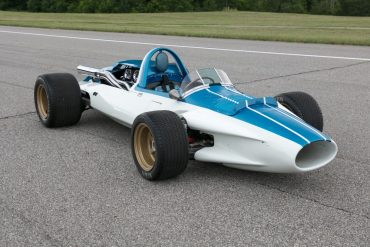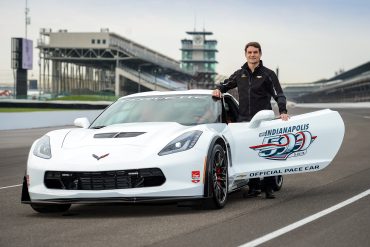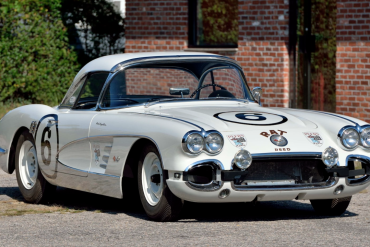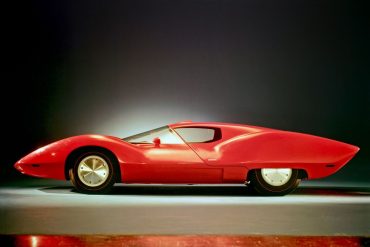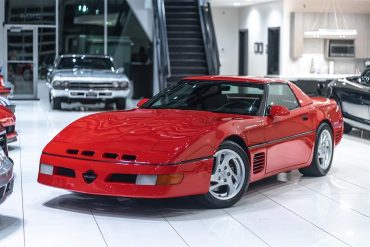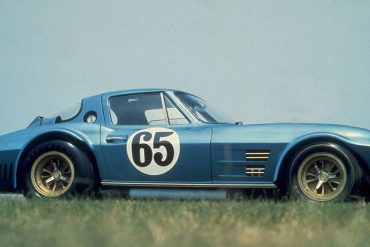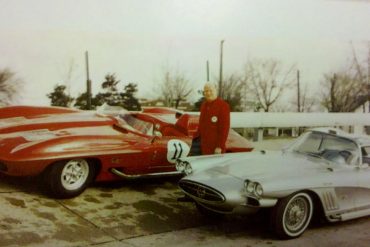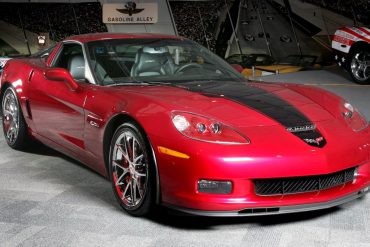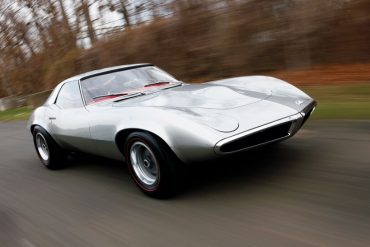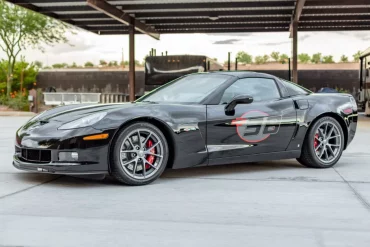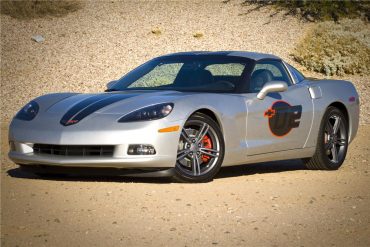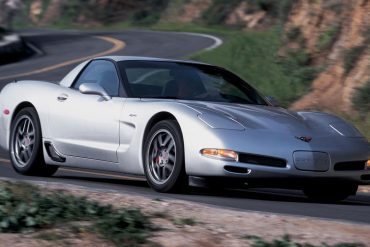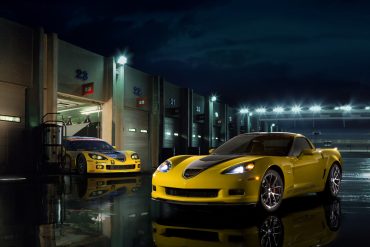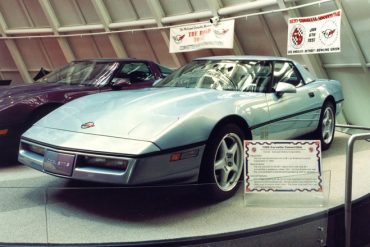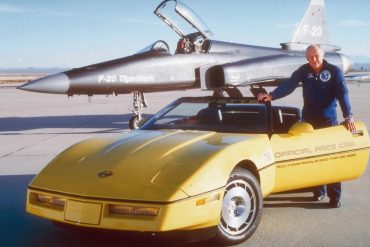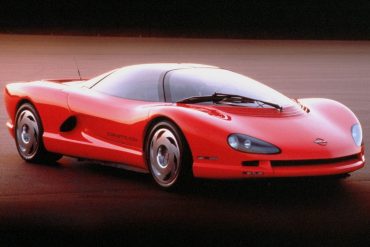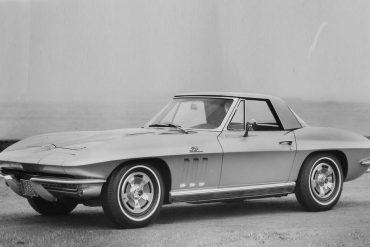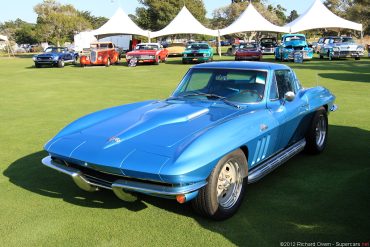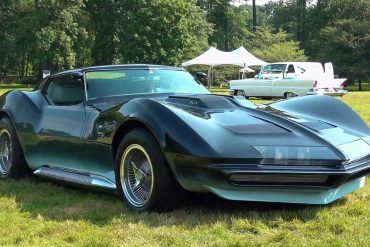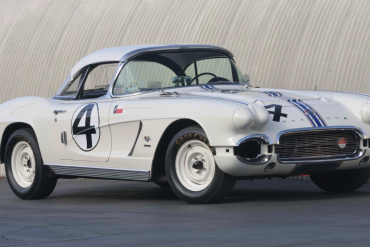In 2006, the company behind the Corvette C6.R pulled out all the stops and developed a Corvette (based on a Z06 donor car and a lot of amazing engineering) that featured an unprecedented amount of horsepower and torque under its hood while packing ultimate luxury inside its ultra-wide carbon-fiber body. The car, which was revealed at the SEMA show in 2007, was called the C6RS Corvette.
Reeves Callaway has always had a dream of competing a Corvette of his own at the 24 Hours of Le Mans, France. The idea begin with the body work for a street version, but one thing led to another, and a full race version was completed as well. The street version is almost identical to the race version because the hood, tail, rocker panels, and lower door halves, are all made of carbon fiber, just like the race version.
A Torch Red 2020 Corvette Stingray coupe will serve as the Official Pace Car for the 104th Indianapolis 500 presented by Gainbridge, continuing Chevrolet’s tradition of leading the field to the green flag. The Pace Car will be driven by GM President Mark Reuss. This marks the 17th time a Corvette has served as the Pace Car, starting in 1978, and the 31st time a Chevrolet has led the field dating to 1948 when a Fleetmaster Six convertible held the honor.
The C4 ZR-1 Corvette, even some 30 years after its initial year of production, carries indisputable performance merit, the likes of which few can deny. In fact, the ZR-1 is often cited as the car which helped fend off threats, both foreign and domestic in origin, to the Corvette's elite performance car status. However, after only 6,939 ZR-1 Corvettes were built, and 6 years of production had passed, the program was terminated, falling victim to decisions regarding pricing.
Built exclusively for Hertz Rental Car, the Corvette ZHZ coupe was first introduced in 2008 as part of Hertz’s “Fun Collection.” These Corvettes were part of a larger group of rental vehicles made up of cars like the Ford Mustang, the Nissan 350Z and the Shelby GT-H. The intent behind these rental cars was simple - provide consumers with an opportunity to rent (at a rate commensurate with the car's performance) a well-equipped sports car for a day, a weekend or even longer.
Various upgrade packages were offered by Motion Industries, for the Chevrolet models included within the Baldwin Corvette partnership. The most prominent of these packages included the SS (425 HP) and Phase III (500+ HP) offerings. These cars not only came with a performance promise, but a guarantee to back it up. All Phase III cars came with a personal guarantee.
For only the second time in Chevrolet history, a Corvette is now available in a Drivers Series special edition. Actually, there’s four, all Grand Sports designed in collaboration with Corvette Racing team drivers Milner, Gavin, Magnussen and Garcia. The idea came from Chevrolet exterior design manager Kirk Bennion, a racing fan who was also at the Rolex 24, according to Corvette Marketing Manager Todd Christensen. Four Drivers Series special editions is definitely more fun than one.
On March 1-2 1990 a unique group of people using a Chevrolet Corvette ZR-1, reset The 24-hour World Speed Record. That achievement proved unequivocally that the car is indeed...King of the Hill. "The 24" had stood for 50 years. Last set at Bonneville in 1940 by AP Jenkins driving the "Mormon Meteor Ill", a purpose-built. single-seat race car with an aircraft engine. The objectives: set the 24 as well as 5000 kilometer and the 5000 mile marks with a ZR-1 while using an L98-powered Corvette to set the six-hour record and other shorter distance marks.
Designed mid-1956 for Harlet Earl’s son Jerry, the SR-2 was put into racing duty in 1957. The car debuted at Daytona Beach in 1957 with a high-speed canopy, fender skirts and bullet-shaped frond headlights. Driven by Betty Skelton and Buck Baker, the car won the modified class with an average speed of 93.074 mph. The SR-2 also finished second in class for the flying mile with a top speed of 152.886 mph.
The CERV II was entirely Zora’s car. The CERV II was conceived early in 1962 and developed over the next year, after the GS program was squashed. The car was built under Zora's direction between 1963-'64. Zora had it in mind to develop a separate line of racing Corvettes but the idea got terminated by management.
The “CERV-1” (Chevrolet Engineering Research Vehicle) was developed as a research tool for that company’s continuous investigations into automotive ride and handling phenomena under the most realistic conditions. The car was built at the Chevrolet Engineering Center at Warren, Michigan in a special project headed by Mr. Zora Arkus-Duntov, Chevrolet Staff Engineer.
The Corvette skipped a year and returned to the Indy 500 in 2015. NASCAR legend Jeff Gordon drove the 'Vette for the first lap, and the car had a fairly simple body with the race decals on the doors and sponsor stickers at the front end. Gordon, who grew up in nearby Pittsboro, Indiana, is no stranger to the Indianapolis Motor Speedway. He won the first NASCAR race in the history of the famed 2.5-mile oval and has won four more times.
Known as the “Race Rat,” this rare 1960 Corvette is one of just 10 produced by the factory with the LPO (Limited Production Option) 1625A 24-gallon fuel tank designed by Zora Arkus-Duntov for racing purposes to reduce the frequency of pit stops. A true factory-prepared race car, this 1960 Chevrolet Corvette Tanker was ordered by gentleman racer and businessman George Reed of “Reed’s Race Rats” fame to compete in 1960 Sebring 12 Hours.
Those that have laid eyes on the Astro I will not soon forget it. This 1967 Chevrolet prototype featured sleek body lines that embodied the feel of a far more aggressively styled Mako Shark. Although the Astro I was built with the intent to aid in the study of aerodynamics, no official documentation has been uncovered as to the results of this testing.
Chevrolet's introduction of the LT1 in 1992 as the base engine in the Corvette phased out the L98 based Callaway Twin Turbo. Previously, Callaway Corvettes made their increased power through positive manifold pressure; now they made it through increased displacement and finesse. Initially called the CL1 or CR1, they designated the chassis they were built upon. They were based on the pushrod LT1 cars (CL1) or the 32 valve DOHC LT5 ZR-1 cars (CR1).
Some of the iconic American sports car’s earliest forays into racing were snuffed out before they ever truly began. The 1963 Corvette Grand Sport, a Zora Arkus-Duntov designed rendition, of the C2 was staged for track domination, both at home and abroad.
Designed and built under the personal supervision of Bill Mitchell, the wild-looking XP-700 used many regular Corvette components (frame, chassis parts and engine). Bill Mitchell had a lot of “customs” built for himself. This XP-700 previewed the new tail of the upcoming 1961 Corvette.
The 427 Limited Edition option, code Q8A and Z44, was limited to 505 examples globally with 427 destined for North American customers. As a retirement gift to Wil Cooksey, the Corvette plant manager from 1993 to 2008, he chose the color scheme and hand signed and numbered the underside of the armrest console lids on all 505 examples in which this example is #6. As part of the package, the seats and the floor mats have “427” embroidery, and the center-console trim plate is color matched.
When first introduced to the world by Pontiac in 1964, the car showed so much promise that Chevrolet (allegedly) put a swift end to its development to prevent its production from hindering the sales of the Corvette. Afterall, with the introduction of the 1963 Split-Window Corvette, Chevy was finally seeing an increase in sales, something lacking for most of the first-gen.
There were only 20 Z06s produced with the Competition Sport package for worldwide purchase. This Z06 is powered by a 7.0-liter LS7 V8 engine producing 505hp and 424 ft/lbs torque, paired to the 6-speed manual transmission. The LS7 engine can propel this Z06 from 0-60 mph in 3.6 seconds. This Z06 CSR features leather interior, articulated sport seats, premium audio system, CD player and heads-up display.
Chevrolet introduced the limited production Competition Sport package for both the 2009 Corvette coupe and the Z06, bringing the look of Corvette's racing team to their non-ZR1 offerings, if not quite the performance. Both the Z06 and Coupe 1LT Vettes ordered with the Competition Sport package will get a track focus, which includes...
A successor to the ZR-1 made its debut in 2001 as the Z06, giving a nod to the high-performance Z06 version of the C2 Corvette of the 1960s. The Z06 uses a tuned version of the standard LS1 engine (designated the LS6), with a higher power output of 385 hp (390 PS; 287 kW), later bumped to 405 hp (411 PS; 302 kW) starting in 2002.
Chevrolet introduced the limited production Corvette GT1 Championship Edition at Sebring International Raceway. The GT1 Championship Edition (Regular Production Option GT1) commemorates the success of Corvette Racing and the Corvette C6R.
There were several successful attempts to build a convertible ZR-1, most of them by private people. The DR-1 was a GM prototype to test the structural integrity of the ZR-1 chassis when it would be topless. The car was built by American Sunroof Corporation (ASC) for Don Runkle, who was the vice-president of Advanced Engineering Staff, which explains the “DR-1” designation. It was a standard convertible transformed to ZR-1 specs.
The big news for 1986 was that a Corvette would pace the Indy 500 for the second time. Retired General Chuck Yeager was enjoying celebrity status as a result of the book and movie, “The Right Stuff.” But Chevrolet was still smarting from the heavy criticism over the ‘78 Corvette Pace Car debacle and decided that all 1986 Corvette convertibles were designated as “Pace Car Replica”.
The 1986 Corvette Indy Prototype was developed beyond clay modeling to the point of a fully-functioning, drivable car, though it was clearly understood that this car would never evolve beyond the prototype stage. Like the clay mock-up before it, development of the mid-engine Indy prototype began in 1985, pulling design cues from its predecessor.
For competition, race customers had a range of options available to them including the N03 36-Gallon Fuel Tank, closer rear axle ratios and the C48 Heater/Defroster Delete (-100). Most cars equipped like this came with either L78 or the L84 with Ram-Jet Fuel Injection.
For competition, race customers had a range of options available to them including the N03 36-Gallon Fuel Tank, closer rear axle ratios and the C48 Heater/Defroster Delete (-100). Most cars equipped like this came with either L78 or the L84 with Ram-Jet Fuel Injection.
The Manta Ray was actually the 1965 Mako Shark II (XP-830) with a few upgrades, so it featured many of the Mako II's outward features, such as side exhausts and a lower-body (along the rocker panels) silver paint job. The front end had a pointed chin spoiler and the headlights used 2 banks of 3 quartz-halogen lights.
Always on the hunt for greater speed and greater thrills, Delmo decided to replace the '61 he had been racing with a brand-new 1962 Chevy Corvette. Owing to his demonstrated skill behind the wheel and prior successes with Corvettes, Delmo had a close relationship with legendary chief engineer Zora Arkus-Duntov and enlisted his assistance with the new car. "It was easy," Delmo recalls. "I called Zora and said, 'Build me a race car.' The only other thing I said was to make it white."


